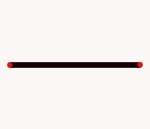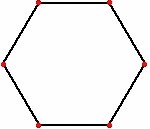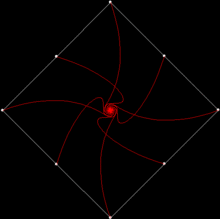Mice problem



In mathematics, the mice problem is a problem in which a number of mice (or insects, dogs, missiles, etc.) are placed at the corners of a regular polygon. Each mouse begins to move towards its immediate neighbour (clockwise or anticlockwise). It must be determined when the mice meet.
The most common version has the mice starting at the corners of a unit square, moving at unit speed. In this case they meet after a time of one unit, because the distance between two neighboring mice always decreases at a speed of one unit. More generally, for a regular polygon of n sides, the distance between neighboring mice decreases at a speed of 1 − cos(2π/n), so they meet after a time of 1/(1 − cos(2π/n)).[1] [2]
Path of the mice
For all regular polygons, the mice trace out a logarithmic spiral, which meets in the center of the polygon (as shown on the right).[3] When additional mice are added and the mice move towards non-immediate neighbours, the paths they trace become more complex.


See also
References
- ↑ George Gamow, Stern, Marvin (1958), Puzzle math, New York: Viking press, pp. 112–114
- ↑ Édouard Lucas, (1877), "Problem of the Three Dogs", Nouv. Corresp. Math. 3: 175–176
- ↑ "Mice Problem". MathWorld. Retrieved 16 April 2013.
External links
- Persecution complex — Extensions of the mice problem